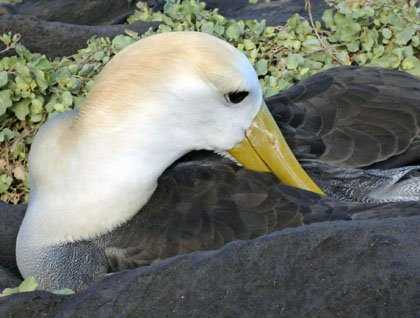Española or Hood Island is the oldest one in Galapagos, at approximately 4 million years of age, so this island has given species more time to evolve in isolation. Even though it is an old island, if you compare its age to the age of the planet itself, which is around 6.4 billion years, we can still see Española as a young formation. As we started to walk among the lava, we could see that erosion had converted the lava flows into boulders over time. The strenuous walk took us to the nesting ground of the waved albatross, one of the part-time inhabitants of this place. We were lucky enough to see the first pair of males circling the landing area and eventually landing, what an incredible sighting this was, and it made the long walk all the more worthwhile.
The albatross is an oceanic bird that only comes to land to reproduce, and they have chosen this particular island because of its cliffs, from where they can take off. Being oceanic, they are big and they need the help of the wind to make it into flight. The mockingbird of Española is one of the four species of mockingbird present in the Galapagos, and this marks the second species that we have encountered so far this week. They are one of the species that got notoriously Darwin’s attention back in 1835. He collected specimens of three out of the four, noticing how they have some physical differences, and he quoted: “there is a difference between the inhabitants of the different islands”…
As we continued our hike along the trail, we had a chance to see the entire breeding cycle of the Nazca Boobies, couples courting, couples making a nest, couples preening each other, parents feeding chicks and independent chicks defying hawks. Normally, hawks prey on booby chicks, but these chicks know that they are too big for the hawks to attack, so they won’t be eaten anymore.
As we returned to the ship at sunset, we contemplated this fragile place and its need to be conserved, not only for us to see, but for the animal species that belong here, the true owners of these islands.







